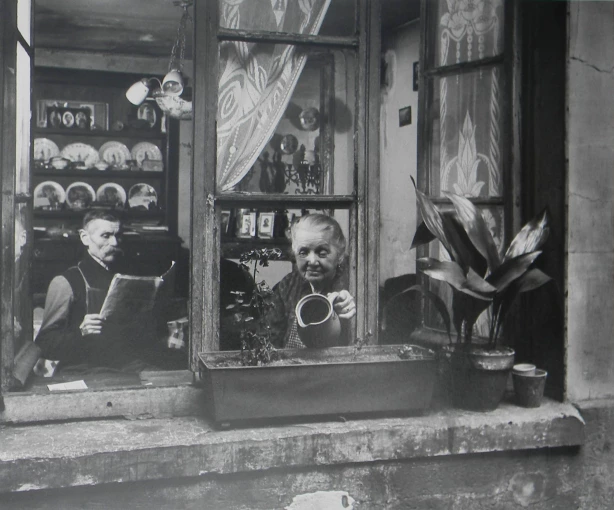Robert Doisneau
Robert Doisneau was a renowned French photographer known for his captivating and often poetic images that captured the essence of everyday life in post-war Paris. He gained fame for his iconic 1950 photograph titled "Le baiser de l'hôtel de ville" (The Kiss by the City Hall).
Biography of Robert Doisneau
Robert Doisneau was born in 1912 in Gentilly, France. He embarked on an artistic journey by enrolling at the renowned École Estienne. In 1929, he completed his studies at the school, earning diplomas in engraving and lithography.
At the age of 16, Robert Doisneau delved into the realm of amateur photography, marking the beginning of his lifelong passion. However, his shyness initially hindered his photographic pursuits. Overcoming his inhibitions gradually, he embarked on his photographic journey by capturing the simple beauty of cobblestones. As his confidence grew, he shifted his focus to photographing children and eventually transitioned to capturing the essence of adults.
In the late 1920s, Doisneau secured employment as a draughtsman specializing in lettering at Atelier Ullmann, a prominent creative graphics studio known for its work in the advertising industry, particularly within the pharmaceutical sector.
In 1931, Doisneau left the advertising studio, taking a job as an assistant to André Vigneau, a notable modernist photographer. A significant breakthrough came in 1932 when Doisneau sold his first photographic story to Excelsior magazine.
In 1934, Doisneau began working as an industrial advertising photographer at the renowned Renault car factory in Boulogne-Billancourt. In 1939, Doisneau faced a setback in his career. Unfortunately, he was dismissed from his position due to his consistent tardiness. Later, Doisneau said that the years at the Renault car factory marked "the beginning of his career as a photographer and the end of his youth."
In 1939, following his departure from the Renault car factory, Doisneau found a new opportunity in the world of photography. Charles Rado, a prominent figure in the field, hired Doisneau at the esteemed Rapho photographic agency. Doisneau traveled throughout France, capturing the essence of everyday life through his lens.
Doisneau's tenure at the Rapho agency was interrupted because of the outbreak of World War II. He was drafted into the French army, where he took on two roles: a soldier and a photographer. After the conclusion of World War II, Doisneau briefly joined the Alliance Photo Agency. However, he soon reconnected with the Rapho agency in 1946.
In 1948, Doisneau's talent and artistic vision caught the attention of Vogue magazine. He was offered a contract to work as a fashion photographer for the esteemed publication. In 1950, Robert Doisneau became a part of Le Groupe des XV group, standing alongside fellow renowned photographers such as René-Jacques, Willy Ronis, and Pierre Jahan.
Throughout his career, Robert Doisneau remained active, diversifying his portfolio and engaging in various photographic endeavors. In addition to his renowned street photography, he ventured into different realms, including producing children's books, capturing advertising photography, and immortalizing notable figures through portraits.
Doisneau's lens captured the essence of numerous renowned individuals, including iconic figures such as Alberto Giacometti, Jean Cocteau, Fernand Léger, Georges Braque, and Pablo Picasso.
Despite his success, Doisneau remained humble and devoted to his craft. He continued to work as a photographer until his death on April 1, 1994, in Montrouge, France, leaving behind a rich legacy of images that continue to inspire and captivate audiences to this day.
Robert Doisneau's art style

Doisneau's photographs are characterized by a modest, playful, and ironic sensibility, often featuring amusing juxtapositions, encounters between individuals from different social classes, and the eccentricities of city life. Influenced by the works of André Kertész, Eugène Atget, and Henri Cartier-Bresson, Doisneau presented a captivating vision of human vulnerability and the transient nature of existence.
Artistic Achievements and Recognition
In recognition of his outstanding contributions to the field of photography, Robert Doisneau received several prestigious honors and accolades throughout his career. Two years after the conclusion of World War II, he was bestowed with the Prix Kodak, an esteemed award that celebrated his remarkable talent and artistic vision.
In 1984, Doisneau was appointed as Chevalier of the Order of the Legion of Honour. In 1991, he was also granted an Honorary Fellowship by The Royal Photographic Society. In 1997, a photo gallery in his name was opened in Gentilly, France, to honor his lifetime work.
Years:
Born in 1912
Country:
France, Paris
Personal website